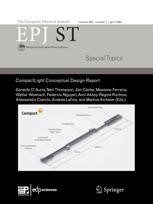Gaining insight into the Universe’s most powerful objects and events
A timely new collection reminds us that even in times of great hardship, our understanding of the Universe’s most explosive, spectacular and mysterious events and objects continues to grow
New York | Heidelberg, 29 July 2021
 Supernovas, neutron stars, and neutron star mergers are some of the Universe’s most powerful events and mysterious objects, leftover after the burning of nuclear fuel is exhausted within massive stars. A new special issue of EPJ Special Topics entitled ‘Nuclear astrophysics in our time: supernovae, neutron stars and binary neutron star mergers’ edited by Debades Bandyopadhyay, Saha Institute of Nuclear Physics, Kolkata, India, brings together several papers that document our understanding of these astrophysical events and compact stars.
Supernovas, neutron stars, and neutron star mergers are some of the Universe’s most powerful events and mysterious objects, leftover after the burning of nuclear fuel is exhausted within massive stars. A new special issue of EPJ Special Topics entitled ‘Nuclear astrophysics in our time: supernovae, neutron stars and binary neutron star mergers’ edited by Debades Bandyopadhyay, Saha Institute of Nuclear Physics, Kolkata, India, brings together several papers that document our understanding of these astrophysical events and compact stars.
The collection comes at an important time for astrophysics and for our understanding of the core collapses that give rise to the supernovas that create neutron stars and black holes. The first measurement of gravitational waves in 2015 by the LIGO/VIRGO collaboration led to the first observation of the merger between neutron stars in a binary system in 2017.
The gravitational wave signal from the shell elliptical galaxy NGC 4993 which became known as GW170817 opened up new avenues for astrophysics and provided astronomy with a massive boost, particularly when it comes to the study of the nuclear processes that occur towards the end of a star’s lifetime.
The publication of this collection is made even more timely by the fact that it also happens to coincide with the 100-year anniversary of the introduction of the Saha thermal ionization equation. The formula integrated atomic physics and statistical mechanics to explain the spectral classification of stars and the processes occurring within the outer layers of such stellar bodies was developed by a young scientist named Meghnad Saha from the University of Calcutta.
Saha wrote the series of papers introducing the equation as the Spanish flu pandemic — ravaged the globe just as the COVID-19 pandemic now causes similar hardship. As such the collection offers a timely and inspiring reminder that even at the most challenging of times, science presses on and our understanding and knowledge of the Universe continues to be refined.
The papers included in the collection also highlight the fact that whilst the understanding of these objects and events is important in itself, our understanding of astronomy and astrophysics hinges on a better grasp of these powerful astrophysical phenomena.
All articles are available here and are freely accessible until 12 September 2021. For further information read the Editorial.
References: D. Bandyopadhyay “Nuclear astrophysics in our time: supernovae, neutron stars and binary neutron star mergers” Eur. Phys. J. Spec. Top. 230, 491–493 (2021). https://doi.org/10.1140/epjs/s11734-021-00009-z
Further Information
For more information visit: www.epj.org
Services for Journalists
The full-text of the Editorial is available here.
Contact
Sabine Lehr | Springer | Physics Editorial Department
tel +49-6221-487-8336 | sabine.lehr@springer.com
